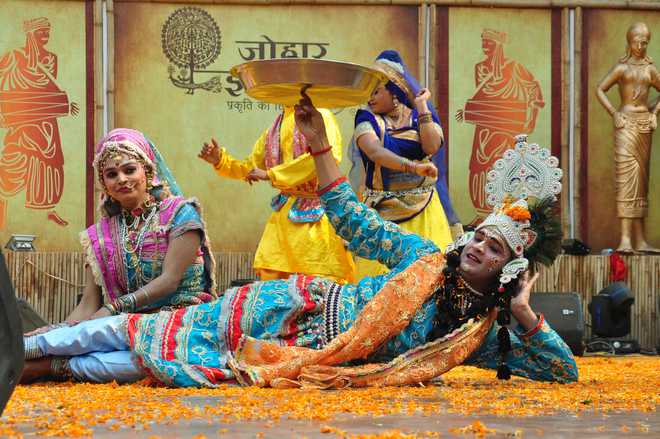
Braj artistes from Uttar Pradesh perform Krishna raas
Sumedha Sharma
From a dark isolated hillock frequented by robbers with rumours of having a haunted pool to boot to a lively picturesque destination for the country's biggest cultural and handicrafts fair, Surajkund has surely come a long way in 30 years. The venue for the fair is an ancient amphitheatre Sunpool built in the 10th century AD by Raja Suraj Pal.
The aim behaind the mela was to show the city folk the ambience and experience of a village haat and to provide rural artisans a platform for their craft and uplift their economic status in the process. Over 80 huts were built in addition to a small chaupal. The architect was Surendra Patel of Gujarat.
In the initial years there was no concept of a theme state and Surajkund was just a village haat where its mud gate caught the fancy of visitors. Since its beginnings the fair has achieved many milestones ever since and is the world's largest handicrafts fair today. In 2013 it was upgraded to an international level.
"The idea behind starting the mela was to promote skilled artisans, who were using indigenous technology, but were suffering due to the cheaper machine-made imitations. Since the first edition of Surajkund Crafts Mela in 1987 that had just 100-odd visitors and 20 artisans to the 31st edition this year when the footfall is in millions and more than 1,500 artisans are participating, it has come a long way and holds a prominent place in the calendar of international cultural events as well," says Rajesh Joon, a spokesperson of the Mela Authority.
The moment you step in the mela grounds the fervour is infectious. Other than brightly-hued stalls, wares and dances what catches the eye is hopeful happy faces of artisans.
Women power
Dressed in yellow salwar kameez Mahua De (26) easily blends in with her bright-coloured pots and pans stacked neatly at her stall. Hailing from a village of the Munda tribal area in Jharkhand, Mahua, a potter, is amused to find 'city madams' drooling over her simple creations like mitti ki tawa.
"This is my first time in Surajkund or any exhibition for that matter. A big handicraft dealer brought us here and wanted me to carry these tawas and handis here. I was confused about his selection as this is our local cookware used only by the very poor who can't afford metal or steel ware. But I have sold over 100 pieces and earned good money, getting my hands on the new two thousand currency note for first time. The demonetization had left me and my family hungry but now I will return with enough money to sustain us for several months," she smiles. Mahua is not alone, more than 200 women artisans like her have benefited at the mela.
Jharkhand was the theme state this year. Artisans from the state, especially tribal areas, brought in a variety of products.
"We make tribal decorative masks. But post demonetization we have not been able to sell even a single piece nor got invites for any exhibition. Coming here was lucky as on the very first day we sold our mega piece worth Rs 15,000. Our Durga masks are a huge hit. I and my five fellow artisans from Santhal plan to buy some shoes for our kids from Delhi," says another woman artisan Mushki Bheel.
Women artisans started making individual entries to the fair in the late nineties.
To promote them and give patronage, the handicrafts ministry gave many incentives.
"Initially, only one or two women, especially potters, would come with their husbands but independent participation by women started in the late nineties. A major concern of these artisans was about the security of their products and their own self owing to the location of the fair. We ensured proper security and provided all conveniences in addition to safe travel. Now most artisans come back again," adds Joon.
Foreign hand
Many foreign artisans are finding the fair a good platform for their wares. Sikander Al-Halvi (60) from war-struck Damascus, is happy to be here. "This fair has rejuvenated me," says Halvi as he cleans his wooden mosaic boxes. He is not alone but has company of many other artisans from 'disturbed' nations, including Egypt and Syria. Artisans from 20 countries have come, a record for international participation in the fair. Countries such as Zimbabwe, Tanzania, Tunisia, Mongolia and South Africa have put up stalls for the first time. Majority of artisans from these countries are not fluent in English and sometimes depend on the sign language and smiles, the universal language.
Creativity in captivity
The fare has much to offer to even those behind bars. Stall number 905 has been put up by Muskan - Haryana Prisons. For the first time the prisons department has put on sale multiple items, including paintings, furniture, fabric and wooden artefacts like mirrors, temples, handmade key chains and hangings, all created by inmates. A brainchild of Yashpal Singhal, DGP Haryana, the idea behind selling these products was inspired from the tremendous response received at an exhibition stall put up at last year's fair. "We have sold over one lakh products this year. This will give boost to the welfare of those on road to reform. This fund will be used to buy raw materials for the prisoners, so that they can further hone their skills," says jail superintendent Deepak Sharma, who is also the nodal officer behind the initiative.
A large number of visitors to the stall were intrigued and impressed by the concept and many brought products.
"When we can support causes like Girl Child or sanitation, animal welfare, etc. then why not for a cause for the betterment of fellow humans who are trying to be better human beings," says Deepak, a visitor who has bought a painting.


























